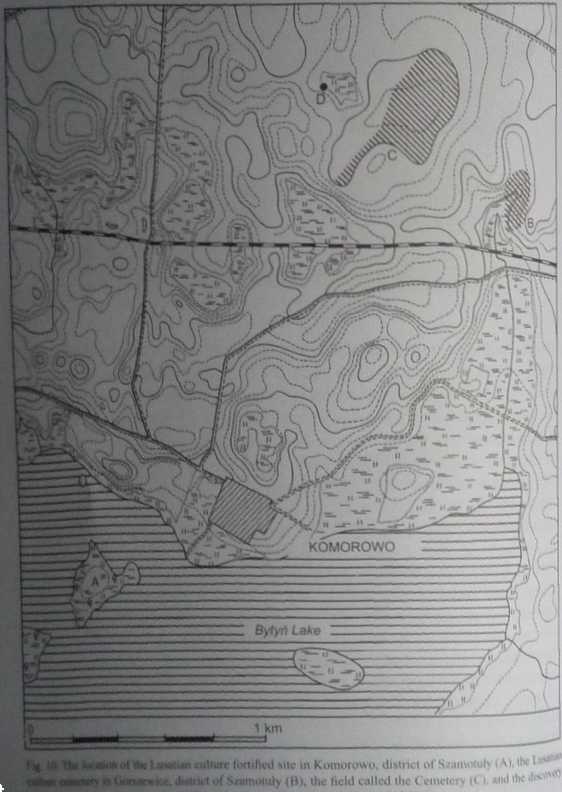51918 P1190337 (2)
230 Tadeusz Malinowski
m Gotszewicc m the 1980's and 1990’s, resultcd in the discovcry of sonie objccis which were imports to this part of Poland (cf. Narożna-Szamałck, Szamałek 1992 and in pnnł).
The opinion that therc | a connection between the cemctery in Gorszewict and the lortified sile in Komorowo front o practical viewpoint cannot be rejeeled; howet er, the only problem would be that some parts of the cemctery arc older

Bi of the ambci lump (D) (aficr Malinowski 2006)
and only to somc extent it was contemporary with the foitified site (cf. e.g.: Malinowski 1973: 94; Bukowski 2002: 99-104. 113). Thcrcfore I would like to point out rwo issucs. The first is a quite subslantial convergcnce of the results of car-tn>n dating for two out of thrcc samples from Gorszewice (Narożna-Szamałck. somałck. in print) and eight out of ninc samples from Komorowo (Skripkin, Ko-almch 2004; Malinowski 2004b), confirming partial coexislence of both the ob-iccts. which mcans that their users could not be unawarc of each other’s presence. Tht second issue is the existence of a Lusatian culture settlcmcnt on the island Jefinitcly before the fortified site was built. a fact which was confirmed by recent excavations in Komorowo. That is proved by pottery found under the clay floor in one of the houses, and moreover. what is equally interesting. the discovery of a lump of amber on the natural subsoil of one of the excavations. It may be the ense - and further excavations on Komorowo Island (hopefully in not-too-distant futurę) carried out on a larger scalę, could resolve the issue — that before the fortified site was built, at least some part of the community which udlized the cem-etery in Gorszewice inhabited the island and was engaged in, among other things. rade in amber and perhaps amber working.
Ilaving indicated the probability of long-distance eon tac ts being madę by the community inhabiting the Lusatian fortified site in Komorowo and burying their dead in the cemetery in Gorszewice, we arrive at the qucstion as to whether the fortified site may be treated as an amber factory located on the Sambian route of the early Iron Agc. Weil, it seems that the coexistence of the raw amber and imports may bc acccptcd as evidcnce supporting the fact that the inhabitants were engaged in amber trade dirccted towards the south and south-west. Ccrtainly. that does not, excludc the possibility that somc part of the amber could havc been processed for local nccds. sińce a few amber bcads were found at the fortified site. and many morę of them at the burial ground. However, we should also State olearly, that somc of the amber objeets discovcred at the latter are rcimports and were not madę on Polish territory (Bukowski 2002: 100-101). On the other hand. the fact that in the early Iron Age amber was transported from the Baltic coast to the south of Europę, where it was processed aceording to local nceds, has been known for quite a long time (e.g.: Malinowski 1970: 742; 1972b: 226; Bukowski 2002: 126). Even a supcrficial catcgorisation of the imports discovcred at the fortified site and cemetery seems to indicatc that. apart from the traditionally indicated regions in the eastem Alps and northem Italy. the regions belonging to the Czech Rcpublic (cf. Bukowski 2002: 119-123, 127). and the ones occupied by the Białowice group of the Lusatian culture. should also bc considered as trade contact arras, cvcn though very few amber objeets were found there (Bukowski 2002: 118-119).
We should also answer the question coneeming the provenanee ot the amber materiał, which was perhaps the moin commodity transported to the above-mentioned arcas within the ambit of the activity of the Komorowo factory It is traditionally accepted that the amber was delivered to Komorowo from the Baltic
Wyszukiwarka
Podobne podstrony:
230 TADEUSZ MALINOWSKI Hyc. 18. Kalinów, gm. Strzelce Opolskie, woj. Opole. Pogorzelisko stosu powst
Types/categories of work The types of work for which P.T.W. systems are normally applied include mai
DESIGN AND PERFORMANCE OF SCREW PILES AND HELICAL ANCHORS IN SOILS (A Bibliography of the Techn
UNIT 3Conservation of Momentum and the Discovery of the Neutrino The Missing Momentum in P Decay In
P1190385 Tomasz Gralak Fig. 9. Iron Agc hcarths and dccoraicd aliars in Europę ordered chronological
sence. The applicability of this law runs counter to the princłple of individuation; that which desp
(e) In RAID Jevels, explain the features of tnose leuels which have very good
democracy in Latin America: conceptual issues and empirical results from 15 States of the region (26
THE RAGA-RASA RELATION IN INDIAN MUSIC 243 Lct us consider the case of instrumental musie which is w
How We Will Proceed In the early chapters we will focus on the behaviour of transmission lines which
Source and vortex fields In our study of electric and magnetic fields we will be greatly aided by th
The Christianization of England - Anglo- Saxons were pagan when they came to Brita
więcej podobnych podstron